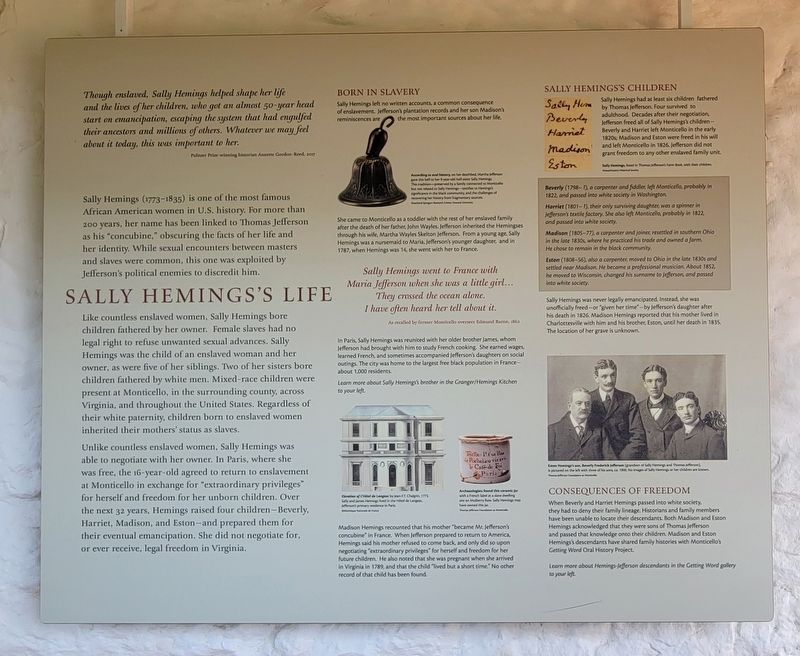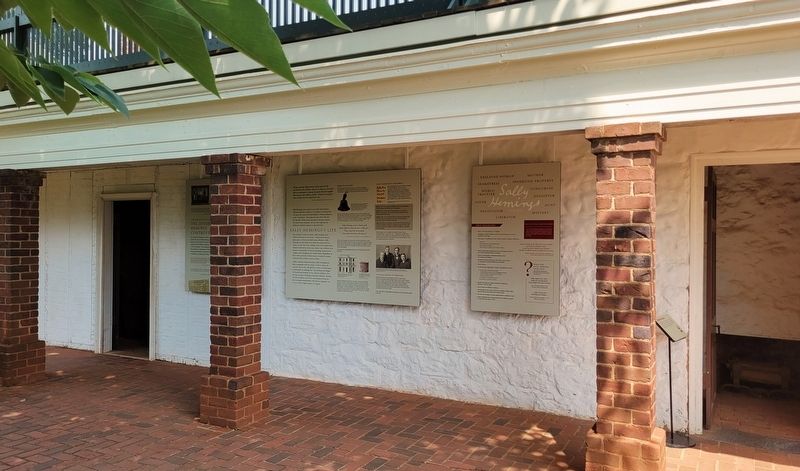Charlottesville in Albemarle County, Virginia — The American South (Mid-Atlantic)
Sally Hemings's Life
Though enslaved, Sally Hemings helped shape her life and the lives of her children, who got an almost 50-year head start on emancipation, escaping the system that had engulfed their ancestors and millions of others. Whatever we may feel about it today, this was important to her.
Pulitzer Prize-winning historian Annette Gordon Reed, 2017
Sally Hemings (1773-1835) is one of the most famous African American women in U.S. history. For more than 200 years, her name has been linked to Thomas Jefferson as his "concubine," obscuring the facts of her life and her identity. While sexual encounters between masters and slaves were common, this one was exploited by Jefferson's political enemies to discredit him.
Like countless enslaved women, Sally Hemings bore children fathered by her owner. Female slaves had no legal right to refuse unwanted sexual advances. Sally Hemings was the child of an enslaved woman and her owner, as were five of her siblings. Two of her sisters bore children fathered by white men. Mixed-race children were present at Monticello, in the surrounding county, across Virginia, and throughout the United States. Regardless of their white paternity, children born to enslaved women inherited their mothers' status as slaves.
Unlike countless enslaved women, Sally Hemings was able to negotiate with her owner. In Paris, where she was free, the 16-year-old agreed to return to enslavement at Monticello in exchange for "extraordinary privileges" for herself and freedom for her unborn children. Over the next 32 years, Hemings raised four children-Beverly, Harriet, Madison, and Eston-and prepared them for their eventual emancipation. She did not negotiate for, or ever receive, legal freedom in Virginia.
Born In Slavery
Sally Hemings left no written accounts, a common consequence of enslavement. Jefferson's plantation records and her son Madison's reminiscences are the most important sources about her life.
She came to Monticello as a toddler with the rest of her enslaved family after the death of her father, John Wayles. Jefferson inherited the Hemingses through his wife, Martha Wayles Skelton Jefferson. From a young age, Sally Hemings was a nursemaid to Maria, Jefferson's younger daughter, and in 1787, when Hemings was 14, she went with her to France.
Sally Hemings went to France with Maria Jefferson when she was a little girl...
They crossed the ocean alone. I have often heard her tell about it.
As recalled by former Monticello overseer Edmund Bacon, 1862
In Paris, Sally Hemings was reunited with her older brother James, whom Jefferson had brought with him to study French cooking.
She earned wages, learned French, and sometimes accompanied Jefferson's daughters on social outings. The city was home to the largest free black population in France-about 1,000 residents.
Learn more about Sally Hemings's brother in the Granger/Hemings Kitchen to your left.
Madison Hemings recounted that his mother "became Mr. Jefferson's concubine" in France. When Jefferson prepared to return to America, Hemings said his mother refused to come back, and only did so upon negotiating "extraordinary privileges" for herself and freedom for her future children. He also noted that she was pregnant when she arrived in Virginia in 1789, and that the child "lived but a short time." No other record of that child has been found.
Sally Hemings's Children
Sally Hemings had at least six children fathered by Thomas Jefferson. Four survived to adulthood. Decades after their negotiation, Jefferson freed all of Sally Hemings's children-Beverly and Harriet left Monticello in the early 1820s; Madison and Eston were freed in his will and left Monticello in 1826. Jefferson did not grant freedom to any other enslaved family unit.
Beverly (1798-?), a carpenter and fiddler, left Monticello, probably in 1822, and passed into white society in Washington.
Harriet (1801-?), their only surviving daughter, was a spinner in Jefferson's textile factory. She also left Monticello, probably in 1822, and passed into white society.
Madison (1805-77), a carpenter and joiner, resettled in southern Ohio in the late 1830s, where he practiced his trade and owned a farm. He chose to remain in the black community.
Eston (1808-56), also a carpenter, moved to Ohio in the late 1830s and settled near Madison. He became a professional musician. About 1852, he moved to Wisconsin, changed his surname to Jefferson, and passed into white society.
Sally Hemings was never legally emancipated. Instead, she was unofficially freed-or "given her time"-by Jefferson's daughter after his death in 1826. Madison Hemings reported that his mother lived in Charlottesville with him and his brother, Eston, until her death in 1835. The location of her grave is unknown.
Consequences Of Freedom
When Beverly and Harriet Hemings passed into white society, they had to deny their family lineage. Historians and family members have been unable to locate their descendants. Both Madison and Eston Hemings acknowledged that they were sons of Thomas Jefferson and passed that knowledge onto their children. Madison and Eston Hemings's descendants have shared family histories with Monticello's Getting Word Oral History Project.
Learn more about Hemings-Jefferson descendants in the Getting Word gallery to your left.
(Captions):
According to oral history, on her deathbed, Martha Jefferson gave this bell to her 9-year-old half-sister Sally Hemings. This tradition-preserved by a family connected to Monticello but not related to Sally Hemings-testifies to Hemings significance in the black community, and the challenges of recovering her history from fragmentary sources.
Moorland-Spingarn Research Center, Howard University
Elevation of L'Hôtel de Langeac by Jean-F.T. Chalgrin, 1773. Sally and James Hemings lived in the Hôtel de Langeac, Jefferson's primary residence in Paris.
Bibliotheque Nationale de France
Archaeologists found this ceramic jar with a French label at a slave dwelling site on Mulberry Row. Sally Hemings may have owned this jar.
Thomas Jefferson Foundation at Monticello
Sally Hemings, listed in Thomas Jefferson's Farm Book, with their children.
Massachusetts Historical Society
Eston Hemings's son, Beverly Frederick Jefferson (grandson of Sally Hemings and Thomas Jefferson) is pictured on the left with three of his sons, ca. 1900. No images of Sally Hemings or her children are known.
Thomas Jefferson Foundation at Monticello
Topics and series. This historical marker is listed in these topic lists: African Americans • Civil Rights • Industry & Commerce • Women. In addition, it is included in the Former U.S. Presidents: #03 Thomas Jefferson series list. A significant historical year for this entry is 2017.
Location. 38° 0.592′ N, 78° 27.142′ W. Marker is in Charlottesville, Virginia, in Albemarle County. Marker can be reached from Monticello Loop, 0.4 miles north of Thomas Jefferson Parkway (Virginia Route 53), on the left when traveling north. Marker is located below the south wing at Monticello. Touch for map. Marker is at or near this postal address: 931 Thomas Jefferson Parkway, Charlottesville VA 22902, United States of America. Touch for directions.
Other nearby markers. At least 8 other markers are within walking distance of this marker. Sally Hemings (here, next to this marker); A Presidential Scandal: (here, next to this marker); Making Monticello (a few steps from this marker); South Pavilion (a few steps from this marker); Mulberry Row (within shouting distance of this marker); Vegetable Garden (within shouting distance of this marker); Smokehouse/Dairy (within shouting distance of this marker); The Levy Legacy (within shouting distance of this marker). Touch for a list and map of all markers in Charlottesville.
Credits. This page was last revised on August 24, 2023. It was originally submitted on August 22, 2023, by Bradley Owen of Morgantown, West Virginia. This page has been viewed 87 times since then and 35 times this year. Photos: 1, 2. submitted on August 24, 2023, by Bradley Owen of Morgantown, West Virginia.

